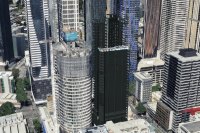
Building Information Modelling (BIM) is being adopted worldwide for building design and construction. But once the building is ready for occupation, what’s the worth of the BIM model?
In our view, when the doors of a building open, the full potential of the BIM model can also be unlocked. An up-to-date, comprehensive model of the facility is a valuable tool for improving operations and maintenance across the building’s full lifecycle.
Asset knowledge is power
BIM – or a digital twin that incorporates BIM – allows efficient and accurate assessment and management of the full inventory of the building’s assets. Each element of the structure, services, fittings and furnishings can be easily located along with important data such as the make, model, serial number, supplier, age, value, maintenance history and schedule, and even the operating manuals.
For operating and maintaining a facility or a portfolio of properties over the long term, this level of knowledge really is power. The more information you have, the better informed your decisions will be and the greater your chance of managing your building efficiently and successfully over the long term.
BIM can provide greater certainty of the actual costs of facilities management based on real data rather than a generic estimate of cost per square metre – and should make tendering for and assessing facilities management contracts quicker and easier. With comprehensive data, a building owner can also get a much clearer picture of their building’s overall valuation, appropriate level of insurance, and return on investment. Efficiencies can be achieved in ordering spare parts and managing inventory.
Crucially, building owners and facilities managers will be able to access the information they need to underpin more proactive, precise and predictive maintenance strategies and plans in line with best-practice asset management standards. The model can highlight which assets require essential statutory maintenance (such as fire detection and suppression systems) or prescribed maintenance (advised by designers and manufacturers to prolong the life of critical assets, such as air conditioning systems and hot water systems), as well as reveal the ‘could do’ maintenance opportunities enabling less-critical assets to operate effectively for longer.
Playing catch-up with retrospective BIM
In an ideal world, BIM would be used effectively and continuously through the design and construction process, with the end-user of the project receiving a complete data set of the installed assets at project completion and handover. However, outside of some new greenfield projects, the reality hasn’t quite caught up.
Nevertheless, for some of our forward-looking clients whose buildings do not have current BIM models, we start by locating whatever data, drawings and models are available and determining which information is most current and accurate. This is rarely as simple as it sounds, given that numerous 2D drawings and 3D models may be managed by different contractors and consultants and maintained at very different levels of accuracy or currency.
We then manipulate, extract and leverage what we can, bringing the available data together in a 3D space for coherent viewing. We apply a custom script to collect and categorise all the assets and assign them to rooms. Much of the modelling effort can be automated and replicated, but every project is unique – so it’s likely that a certain amount of innovation and detailed manual work will be needed to manipulate a model’s rules to accommodate non-conforming attributes.
It is essential to verify that the new model and the physical reality match and to fill in any gaps in knowledge. This physical asset audit is laborious, particularly for very large and complex facilities. Many components of existing building services are hidden behind walls or other surfaces – so it’s not a quick or easy matter to locate and check every element.
The result of these efforts should be a robust, accurate repository of building data that the facilities management team and the building owner can easily access, update or extract to merge with their usual business software.
Earlier is easier
Rather than working backwards after a building is completed, we recommend that any developer of a new building – and especially those developers now building to rent – should embrace BIM as early as possible to harness maximum benefits for design, construction and long-term facilities management.
This means getting the right specialist support early to develop a BIM execution plan suited to the facility and able to fulfil all the intended use cases. Ultimately, the earlier you involve skilled, experienced people who understand the technology and your purpose/s, the more likely you’ll be to get the best from your data, know your assets, minimise risk and optimise costs throughout the life of your building.
About the authors
Adam Adkin is WT’s Asset & Facilities Management Lead and a State Director, based in Brisbane. Adam brings extensive experience in Facilities Management with a key focus on strategy and performance management. A published authority on Asset Data Capture and Asset Management Principles, Adam applies his advanced technical and personal skills to successfully advise WT’s many clients across varied sectors and widely diverse projects in the construction and engineering industries.
Armano Papageorge is WT Australia’s BIM Lead. He brings over 10 years’ experience working in architecture, engineering, and cost management professional services. Armano has worked on a wide range of BIM-driven projects spanning different scales, disciplines, and typologies. His career is marked by a dedication to delivering innovative and efficient project outcomes at all phases of the project lifecycle. Armano is passionate about educating the next generation of construction professionals on the advancements in digital construction. He pushes the boundaries of what is possible with BIM and other construction technologies, striving to make the built environment smarter, faster, and more cost effective.







